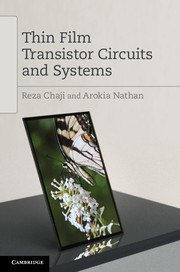Refine search
Actions for selected content:
1808 results in Circuits and systems
Index
-
- Book:
- X-Parameters
- Published online:
- 05 October 2013
- Print publication:
- 26 September 2013, pp 216-219
-
- Chapter
- Export citation
3 - Spectral linearization approximation
-
- Book:
- X-Parameters
- Published online:
- 05 October 2013
- Print publication:
- 26 September 2013, pp 45-87
-
- Chapter
- Export citation
Appendix E - Solutions to exercises
-
- Book:
- X-Parameters
- Published online:
- 05 October 2013
- Print publication:
- 26 September 2013, pp 206-215
-
- Chapter
- Export citation
5 - Multi-tone and multi-port cases
-
- Book:
- X-Parameters
- Published online:
- 05 October 2013
- Print publication:
- 26 September 2013, pp 112-149
-
- Chapter
- Export citation
Acknowledgments
-
- Book:
- X-Parameters
- Published online:
- 05 October 2013
- Print publication:
- 26 September 2013, pp xv-xvi
-
- Chapter
- Export citation
2 - X-parameters – fundamental concepts
-
- Book:
- X-Parameters
- Published online:
- 05 October 2013
- Print publication:
- 26 September 2013, pp 20-44
-
- Chapter
- Export citation
6 - Memory
-
- Book:
- X-Parameters
- Published online:
- 05 October 2013
- Print publication:
- 26 September 2013, pp 150-188
-
- Chapter
- Export citation
Appendix D - Wide-band memory approximation
-
- Book:
- X-Parameters
- Published online:
- 05 October 2013
- Print publication:
- 26 September 2013, pp 204-205
-
- Chapter
- Export citation
Appendix A - Notations and general definitions
-
- Book:
- X-Parameters
- Published online:
- 05 October 2013
- Print publication:
- 26 September 2013, pp 189-195
-
- Chapter
- Export citation
Appendix C - Parallel Hammerstein symmetry
-
- Book:
- X-Parameters
- Published online:
- 05 October 2013
- Print publication:
- 26 September 2013, pp 202-203
-
- Chapter
- Export citation

Fundamentals of Ultra-Thin-Body MOSFETs and FinFETs
-
- Published online:
- 05 September 2013
- Print publication:
- 29 August 2013

Thin Film Transistor Circuits and Systems
-
- Published online:
- 05 September 2013
- Print publication:
- 29 August 2013
Appendix B - OLED electrical calibration
-
- Book:
- Thin Film Transistor Circuits and Systems
- Published online:
- 05 September 2013
- Print publication:
- 29 August 2013, pp 151-156
-
- Chapter
- Export citation
Appendix A - Enhanced voltage driving schemes
-
- Book:
- Thin Film Transistor Circuits and Systems
- Published online:
- 05 September 2013
- Print publication:
- 29 August 2013, pp 142-150
-
- Chapter
- Export citation
Preface
-
- Book:
- Thin Film Transistor Circuits and Systems
- Published online:
- 05 September 2013
- Print publication:
- 29 August 2013, pp viii-x
-
- Chapter
- Export citation
Preface
-
- Book:
- Fundamentals of Ultra-Thin-Body MOSFETs and FinFETs
- Published online:
- 05 September 2013
- Print publication:
- 29 August 2013, pp vii-viii
-
- Chapter
- Export citation
5 - Charge-based driving scheme
-
- Book:
- Thin Film Transistor Circuits and Systems
- Published online:
- 05 September 2013
- Print publication:
- 29 August 2013, pp 93-113
-
- Chapter
- Export citation
Symbols
-
- Book:
- Fundamentals of Ultra-Thin-Body MOSFETs and FinFETs
- Published online:
- 05 September 2013
- Print publication:
- 29 August 2013, pp x-xiv
-
- Chapter
- Export citation
References
-
- Book:
- Thin Film Transistor Circuits and Systems
- Published online:
- 05 September 2013
- Print publication:
- 29 August 2013, pp 157-166
-
- Chapter
- Export citation
2 - Unique features of UTB MOSFETs
-
- Book:
- Fundamentals of Ultra-Thin-Body MOSFETs and FinFETs
- Published online:
- 05 September 2013
- Print publication:
- 29 August 2013, pp 13-102
-
- Chapter
- Export citation
